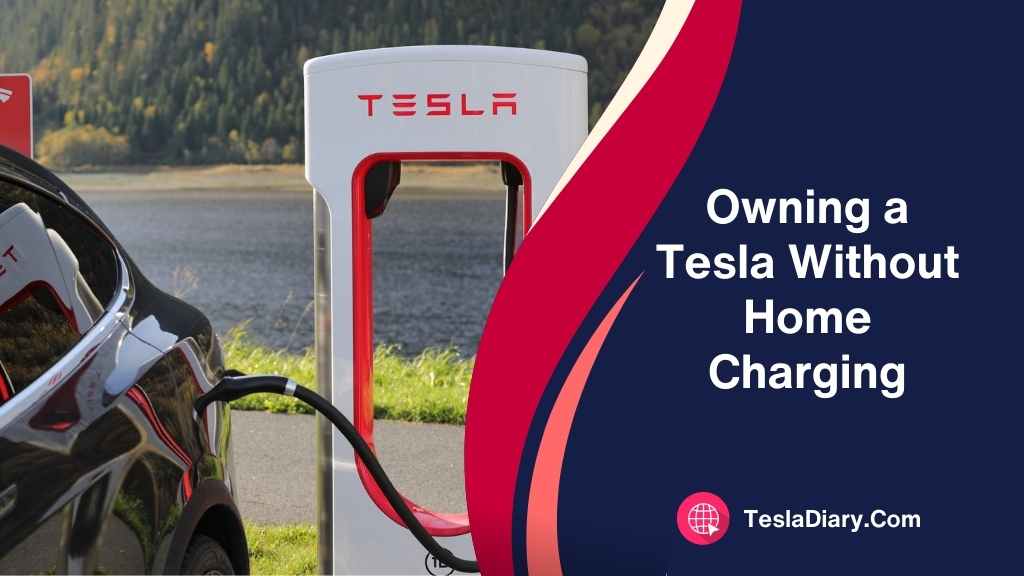Tesla electric vehicles have transformed the automotive industry, offering cutting-edge technology, impressive performance, and eco-friendly driving.
For many potential Tesla owners, the question arises: Is it possible to own a Tesla without access to a dedicated home charging station?
In this comprehensive guide, we’ll explore the various options and considerations for Tesla ownership without the convenience of home charging.
Can You Own a Tesla Without a Home Charger?
Yes, you can own a Tesla without a home charger, but it may require some additional planning and consideration for your charging needs. Tesla offers a range of charging options to accommodate different living situations and lifestyles:

Public Charging Stations
One of the primary solutions for Tesla owners without home charging is to utilize public charging stations. Tesla has built an extensive network of charging infrastructure, providing several options for electric vehicle (EV) owners.
Superchargers
Pros:
- Fast Charging: Tesla Superchargers are known for their rapid charging capabilities, adding a substantial amount of range in a short time.
- Convenience: These chargers are strategically placed along highways and in urban areas, making long-distance travel convenient.
- Tesla Exclusive: Superchargers use Tesla’s proprietary technology, ensuring compatibility with your vehicle.
Cons:
- Availability: While Superchargers are abundant in many regions, they may be less common in rural areas.
- Routing: Planning long trips may require occasional detours to reach Superchargers.
Destination Charging
Tesla also offers Destination Chargers at various locations, such as hotels, restaurants, and shopping centers. Although these chargers are typically slower than Superchargers, they can be invaluable for topping up your battery during daily activities.
Pros:
- Convenience: Ideal for short stops and overnight stays.
- Network Expansion: Tesla continues to expand its Destination Charging network, offering more options at popular destinations.
- Cost: Many Destination Chargers are free for customers patronizing associated businesses.
Cons:
- Charging Speed: Slower compared to Superchargers.
- Availability: The availability of Destination Chargers may vary depending on the location.
Charging at Work
Another practical solution for Tesla owners without a home charger is workplace charging. If your employer provides charging stations, you can conveniently charge your Tesla while you work.
Pros:
- Daily Convenience: Charging your Tesla at work ensures your vehicle is adequately charged for your daily commute.
- Employee Benefits: Some employers offer workplace charging as an employee benefit, potentially reducing your charging costs.
- Reduced Reliance on Public Charging: Regular workplace charging reduces the need to rely on public charging stations.
Cons:
- Limited Hours: Workplace charging is typically available during work hours only.
- Availability: Workplace charging depends on whether your employer offers this amenity.
Public Charging Apps
To make the most of public charging options, consider using dedicated smartphone apps and websites that help you locate and navigate to available charging stations. These platforms often provide real-time information about station availability, pricing, and more.
Pros:
- Easy Locating: Charging apps simplify the process of finding the nearest charging station.
- Information Access: Charging apps provide essential details about charging rates and payment methods.
- Rewards: Some apps offer rewards, discounts, or loyalty programs for frequent use.
Cons:
- Data Dependency: Relying on mobile data or Wi-Fi for real-time updates may be required.
- Subscription Fees: Some apps may require a subscription or additional fees for advanced features.
Charging Adapters
Tesla offers a range of adapters that allow you to connect your Tesla to various charging standards beyond Tesla’s proprietary connectors. These adapters enhance flexibility and make it easier to utilize non-Tesla charging infrastructure.
Pros:
- Enhanced Flexibility: Adapters provide increased flexibility for charging, allowing you to access a variety of charging networks.
- Compatibility: These adapters ensure compatibility with different types of charging stations.
- Cost-Effective: Investing in adapters is a cost-effective way to bridge the gap between your Tesla and non-Tesla charging stations.
Cons:
- Additional Cost: Adapters add to the overall cost of ownership.
- Management: You’ll need to carry and manage these adapters, which could be cumbersome.
Tips for Owning a Tesla Without Home Charging
Here are some valuable tips to help you make the most of your Tesla ownership experience without a home charger:
Plan Your Charging Stops:
Before embarking on a long trip, use Tesla’s navigation system or charging apps to identify Superchargers and other charging stations along your route. Plan your stops accordingly to ensure you have ample charging opportunities.
Utilize Workplace Charging:
If your workplace offers charging stations, make it a routine to charge your Tesla while at work. This can significantly reduce your reliance on public charging infrastructure.
Consider Charging Adapters:
Depending on your region and travel habits, investing in charging adapters like the CHAdeMO or J1772 adapters can provide access to a wider range of charging options.
Monitor Your Battery:
Keep a close eye on your Tesla’s battery level, especially when relying on public charging. Aim to charge before reaching critically low levels to avoid range anxiety.
Plan Charging During Off-Peak Hours:
If you’re paying for charging by the kilowatt-hour, consider charging during off-peak hours to reduce costs.
Conclusion
In conclusion, owning a Tesla without a home charger is entirely feasible and practical. Tesla’s extensive Supercharger network, Destination Chargers, workplace charging options, and the availability of charging adapters ensure that Tesla owners have viable solutions for charging on the go.
While home charging offers unparalleled convenience, these alternatives empower Tesla enthusiasts to enjoy their electric vehicles without the need for a dedicated home charging station.
By following the provided tips and leveraging the existing infrastructure, owning a Tesla without a home charger can be a rewarding and eco-friendly experience.

